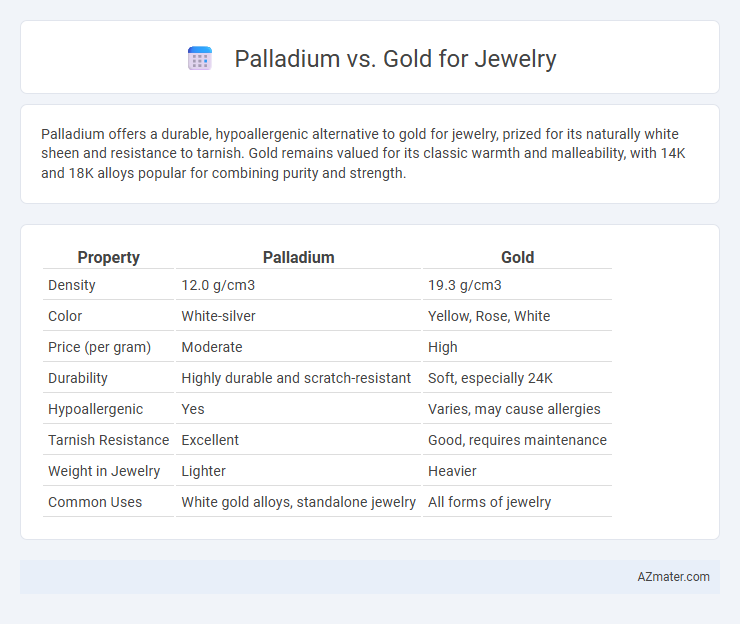Palladium offers a durable, hypoallergenic alternative to gold for jewelry, prized for its naturally white sheen and resistance to tarnish. Gold remains valued for its classic warmth and malleability, with 14K and 18K alloys popular for combining purity and strength.
Table of Comparison
| Property | Palladium | Gold |
|---|---|---|
| Density | 12.0 g/cm3 | 19.3 g/cm3 |
| Color | White-silver | Yellow, Rose, White |
| Price (per gram) | Moderate | High |
| Durability | Highly durable and scratch-resistant | Soft, especially 24K |
| Hypoallergenic | Yes | Varies, may cause allergies |
| Tarnish Resistance | Excellent | Good, requires maintenance |
| Weight in Jewelry | Lighter | Heavier |
| Common Uses | White gold alloys, standalone jewelry | All forms of jewelry |
Overview of Palladium and Gold in Jewelry
Palladium and gold are both popular precious metals used in jewelry, with palladium belonging to the platinum group and known for its naturally white sheen and durability, making it resistant to tarnish and ideal for sensitive skin. Gold, a traditional favorite, is valued for its rich yellow hue, malleability, and availability in various karats that affect its purity and strength, commonly alloyed with metals like copper or silver to enhance hardness. While gold offers timeless appeal and color options such as yellow, white, and rose, palladium is favored for its lightweight nature and hypoallergenic properties, often chosen for modern and minimalist jewelry designs.
Physical Properties: Palladium vs Gold
Palladium is a naturally white metal with a high resistance to tarnish, featuring a lighter density of approximately 12 g/cm3 compared to gold's 19.3 g/cm3, making palladium jewelry more lightweight and comfortable for everyday wear. Gold, especially in its pure 24k form, is softer with a Mohs hardness around 2.5 to 3, whereas palladium rates higher at about 4.75 on the Mohs scale, providing greater durability and scratch resistance. Both metals have excellent corrosion resistance, but palladium's lower melting point around 1555 degC versus gold's 1064 degC influences casting techniques and manufacturing methods in jewelry production.
Color and Appearance Comparison
Palladium displays a naturally white, lustrous color that resists tarnishing, maintaining its bright, silvery appearance without the need for rhodium plating unlike gold, which typically ranges from yellow to rose hues depending on alloy composition. White gold requires rhodium plating to achieve a similar bright white finish as palladium but may dull or yellow over time. Palladium's lightweight nature and consistent coloration make it a preferred choice for modern, sleek jewelry designs compared to the traditional, heavier feel and warm tones of gold.
Durability and Wear Resistance
Palladium offers superior durability and wear resistance compared to gold, making it an ideal choice for everyday jewelry such as wedding bands and rings. Its naturally white hue requires less maintenance and polishing than gold, especially white gold, which often relies on rhodium plating that wears off over time. Palladium's high resistance to scratches and tarnish ensures longevity, while gold, particularly in lower karats, is softer and more prone to dents and surface damage.
Hypoallergenic Qualities and Skin Sensitivity
Palladium is increasingly favored over gold for jewelry due to its hypoallergenic properties, making it ideal for individuals with sensitive skin or metal allergies. Unlike gold, which often contains nickel or other alloys that can cause irritation, palladium is naturally nickel-free and less likely to trigger allergic reactions. This makes palladium jewelry a safer and more comfortable option for prolonged wear among those prone to skin sensitivity.
Weight and Comfort for Everyday Wear
Palladium is significantly lighter than gold, offering a comfortable and durable option for everyday wear due to its weight of approximately 12 g/cm3 compared to gold's heavier 19.3 g/cm3. Its natural white sheen requires less maintenance and polishing than gold, making it ideal for individuals seeking low-maintenance luxury. The lightweight nature of palladium reduces finger fatigue and enhances comfort, while gold's density often results in a more substantial feel but can be less practical for prolonged daily use.
Price Differences and Market Value
Palladium jewelry typically costs less than gold due to its lower density and scarcity in consumer markets, making it an affordable alternative for premium white metals. Gold maintains a higher market value because of its longstanding cultural significance, recognized purity standards, and demand in investment and luxury sectors. Price fluctuations in palladium are often driven by industrial demand, particularly in automotive catalytic converters, while gold prices are influenced by global economic conditions and inflation hedging.
Maintenance and Care Requirements
Palladium jewelry requires less frequent polishing than gold due to its naturally tarnish-resistant properties, making it ideal for low-maintenance wearers. Gold, especially higher karat values like 18K and 24K, demands regular cleaning and occasional replating to maintain its luster and prevent scratches. Both metals benefit from careful storage and avoidance of harsh chemicals, but palladium's hypoallergenic and durable nature often results in easier long-term care compared to gold.
Ethical Sourcing and Environmental Impact
Palladium jewelry often surpasses gold in ethical sourcing due to its typically lower environmental footprint and more transparent supply chains, with many palladium mines adhering to strict environmental and labor standards. Gold mining is associated with significant environmental damage, including habitat destruction and toxic chemical use, raising concerns over sustainability and ethical practices. As consumer demand for eco-friendly jewelry grows, palladium presents a more sustainable and ethically responsible option compared to traditional gold.
Choosing Between Palladium and Gold for Your Jewelry
Palladium and gold differ significantly in weight, color, durability, and price, making the choice crucial for jewelry buyers. Palladium is lighter, naturally white, hypoallergenic, and more affordable compared to gold, which is heavier, available in various colors like yellow, white, and rose, and known for its classic luxury appeal. Selecting between palladium and gold depends on preferences for metal weight, skin sensitivity, maintenance needs, and budget constraints.

Infographic: Palladium vs Gold for Jewelry
 azmater.com
azmater.com